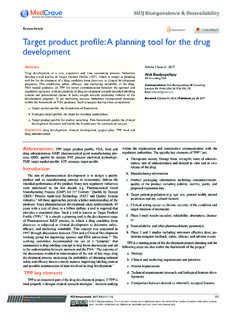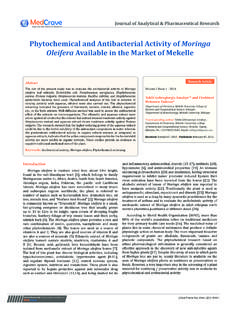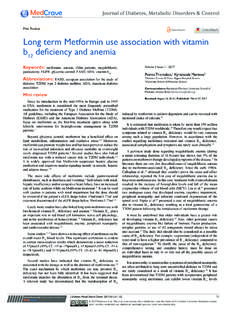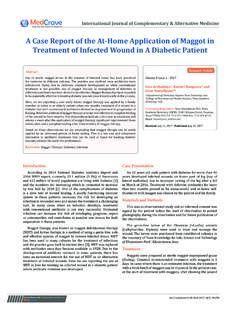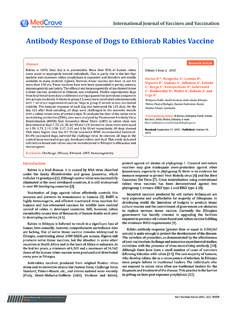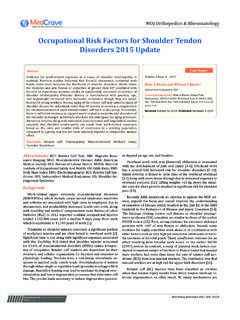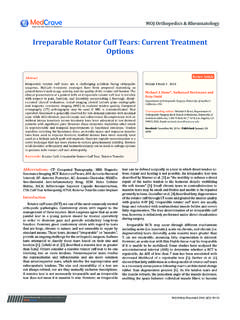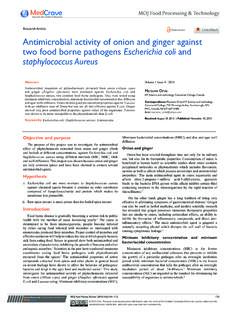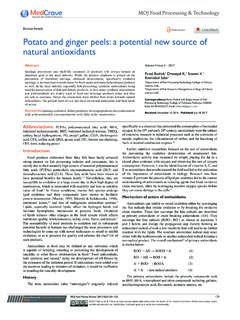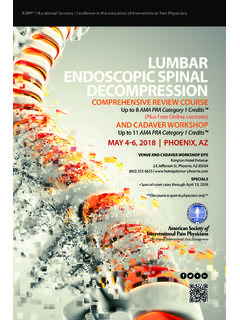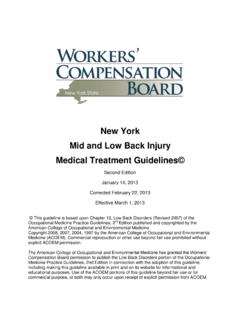Transcription of Epidural Steroid Injection Warning & Safety …
1 Journal of Anesthesia & Critical Care: Open Access Epidural Steroid Injection Warning & Safety recommendations Volume 2 Issue 5 - 2015 Helen Gharaei* Anesthesiologist, Iran*Corresponding author: Helen Gharaei, Anesthesiologist, Pain Specialist, MD-FIPP, Milad Hospital, Iran, Tel: +989198923151, Email: Received: July 12, 2015 | Published: July 31, 2015 Editorialparaplegia, stroke, bowel/bladder dysfunction, cauda equina syndrome, thrombosis/thromboembolism, sensory disturbances, blindness (transient and possible permanent), seizures, psychological/behavioral changes, sever disability and death [3,4].
2 While the FDA does not control medicine but announce warn issues that can affect medicine. In 2009 Rathmell reported complication of ESIs to FDA. According to this report, FDA Safety review begun. Issues that have been studied since that time include: label kelong not approval for Epidural use, Injection is not safe in arachnoiditis, a survey of the meningitis outbreak due to ESIs, classes and communication about the dangers of injecting and ADDPAC (anesthetic and analgesic drug products Advisory Committee) meeting 2014 [5].With the advancement of pain education, it seems necessary to warn about the use of Epidural corticosteroid more and more.
3 We should educate our patients about side effects of the injections at discharge time, that in the case of complication refer to the emergency department as soon as possible to prevent irreversible neurologic events. Following is Safety recommendations that may reduce risks to patients and should facilitate defend physicians from claims. Remember, this Injection is a procedure that must follow the general rules of all procedures. Provide detailed informed consent. Take a careful history. Inform diabetic patients concerning augmented risk of infection in addition the likelihood of hyperglycemia.
4 Raise concerning the utilization of antiplatelet medicine and anticoagulants. Be familiar with contraindications to corticosteroids. Perform physical examination and document preexisting neurologic abnormalities and search for any skin bruising or anatomic variation [6].a) Algorithmic approach to interventional pain management limited use of ESI to special cases [7]. So perform the procedure for proper indications. It s typically ineffective for axial or nonspecific low back or neck pain [5].b) Avoid deep sedation. The deeply insensible patient could become agitated and will move unexpectedly and could not alert us to the fact that we ve got the nerve root or cord [8-10].
5 C) Consider a local anesthetic test dose before Steroid Injection . Limit the entire local anesthetic to a quantity that s safe if delivered intrathecally. d) Obtain and view MRI scans before the procedure. If there s pre existing canal stenosis and spinal cord compression, the extra pressure created by the volume of drug injected, might end in neurologic injury, considerably if there s some loss of performance [6].e) Inject contrast, under live fluoroscopy after aspiration, then obtain an image to ensure that the dye pattern has not changed. If obtainable, use digital subtraction [11-13]. Inject dye through tiny extension conduit to reduce needle tip movement between dye and Steroid Injection [6].
6 F ) Check magnetic resonance imaging for the presence of arachnoiditis before the procedure, although it is controversial [14,15].g) Consider interlaminar approach, significantly for cervical injections. Epidural needle placement above C6-7 is not suggested [6].h) There is an increased chance of neurologic injury with transforaminal Epidural approach compared to the interlaminar approach. Use of image-guidance is necessary for performing transforaminal injections. Do not inject through postoperative scar tissue [15].
7 Transforaminal injections with blunt needles decrease complications [16-18]. In lumbar (L) region use transforaminal Injection only under L3. Even under L3 take the needle far from anterior Epidural space. In upper L3 prefer to use diagnostic selective nerve root block and radiofrequency of dorsal root ganglion (DRG). Perform intercostals nerve Injection instead of selective nerve root Injection in the thorax. It is not recommended in the cervical zone anymore and selective nerve root block and radiofrequency of DRG are substituted [16-20]. Pulse radiofrequency and its antiinflamatory impact may be a substitute for Steroid [21,22].
8 There is an increased probability of neurologic injury once particulate steroids are used for transforaminal injections. Minimize the number of Steroid injections, considering a repeat Injection of steroids after a minimum of two weeks. Take Submit Manuscript | Anesth Crit Care Open Access 2015, 2(5): 00069 EditorialA recent rapid increase in the utilization of Epidural Steroid Injection (ESI) for the treatment of spine pain lead to many negligence claims. This procedure nearly doubled since 2000. In 2012, more than one million claims reported [1].
9 In the 2000s, chronic pain management involved 18%, acute pain management 9% and obstetric anaesthesia formed 8% of claims, while Epidural injections were the most common chronic pain Injection [2]. The Food and Drug Administration (FDA) issued a Warning letter in 2014, that ESIs is dangerous and may lead to spinal cord infarction, paralysis, quadriplegia, paraparesis/under consideration use of non-particulate steroids. Although, there s very little proof that soluble steroids have equivalent effectiveness, and early studies indicated that soluble Steroid preparations stay within in the spinal canal just for transient periods [4,5,15,23-25].
10 Local anesthetic could also be as effective as either particulate or non-particulate steroids [15]. Particles larger than twenty microns in a solution additionally will increase the probability of vascular occlusion, mix steroids with caution, particularly with lidocaine. If the drug combination is necessary, be injected immediately [26]. What is clear is that if complications occur, it would be devastating. Doctors skills are important, especially because many of these doctors have not completed the pain fellowship training. The physician may be a candidate for the injections should be approved by the Medical Council for scientific and practical qualifications.
